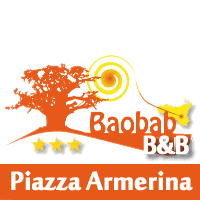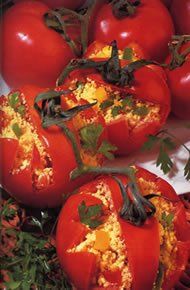Home - In and around
ENOGASTRONOMIA
Gastronomy
Whoever visits Vittoria definitely must taste the numerous "specialties" of centenarian tradition and the world famous, controlled domination of origin, Cerasuolo Wine and Ciliegino Tomato.
Cerasuolo Wine
It is produced in the mesopotamic historical territory between Ippari and Dirillo (they're rivers).
It's obtainable from "frappato's grape" and "nero d'Avola", autochtone sicilian wine, that produce choice wines, with characteristic colour and typical, unmistakable scente. It is advised to drink at 18°-20° C.
It's combined to seasoned chees, red meats, tipycal area dishes, roats and fishes, to vigorous taste exalting tastes and spices.
Ciliegino Tomato
It improved with age the leading role in our tradition cookery. In particulary Ciliegino Tomato has carried in european tables, newness gust of wind. In the "ragusano" territory, there are enormous quantitative, in particular in Vittoria. This is a food that offers a modest quantity of proteins, in fact we found it in hypocaloric diets. A lot of mineral salts and also vitamins A, B1, B2 and above all C. It scientifically settled that tomato holds the "licopene" a substance avallable to reduce infart's risk and the incidence of some cancers. The "Ciliegino" is a food fits at each taste. It can be take raw, tasting with wonderful hors-d'oeuvres or salads otherswide done.
Among the first course dishes, remarkable are the ricotta cheese ravioli and the home-made pastas: lasagne, cavatieddi, pastrattata, mpanati and scaccie (focacce).
RAVIOLI: made of thin layered pasta and cheese ricotta filling they are cooked in salted boiling water and then 'covered' with meat and/or sausage sauce.
CAVATIEDDI: made out of a soft dough of flour and water and cut into small cylinder shaped pieces then pressed with a fork. They are served with meat sauce, peas or fresh ricotta cheese.
PASTRATTATA: a vegetable or legumes soup into which flour is slowing poured in order to form a creamy textured mixture then seasoned with olive oil.
MPANATI: typical Easter dish, formed by 2 circular disks of bread dough with a filling of vegetables, potatoes and lamb meat.
SCACCIE (FOCACCIE): Primarily a Christmas dish (but prepared all year round). The scaccie are prepared with a very thin layer of bread dough rolled out into rectangular sheets and filled to please: ricotta cheese and parsley; spinach and raisins; tomatoes and onions; cauliflower; ecc.
They are baked to golden brown.
ARANCINI: a mixture of rice and meat sauce, with filling of meat, peas and cheese deep-fried in abundant oil.
Among the main course dishes: fish platters with grilled anciovi (sardines), fish soups, cold octopus salad, deep-fried fish, raw echinus (ricci), muscles au gratin, ecc.
The local "trigghiuledda", very young mullets covered with flour, basil and tomatoes cut into small dices and fried all together in a sort of flan are great.
Worth mentioning are the vavaluci and the vaccareddi (small and large snails) considered delicacies. They are boiled and seasoned with oil and crude oil, or cooked like a stew.
Among the side dishes:
The famous Caponatina ( sweet-sour caponata ) with aubergines, sweet peppers, celery, capers and olives.
The zucca gialla (squash) fried and seasoned with wine vinegar.
I cipudduzzi (lampasciuoli) - small bitter bulbs cooked in boiling water. The can be eaten boiled and seasoned with olive oil, garlic and lemon or made tastier if lightly fried with tomatoe sauce, vinegar and a dab of sugar.
And now to the typical desserts that are prepared in the different periods of the year:
In September people prepare the cutugnata (a marmalade of quince-apples) made with boiled apples that are sieved and therefore cooked in equal parts with sugar. The marmalade then is put to dry out in various shaped terracotta moulds.
Coinciding with vintage time is the preparation of the mustata: wine worth cooked with superfine wheat bran flavoured with cinnamon and toasted hulled almonds. It is enjoyed hot or cold, after being dried out in terracotta moulds.
For St. Martin's Feast people prepare i friteddi (frittelle) sweet or salted doughnuts: a very soft dough made with flour and yeast that is deep-fried in much oil. The doughnuts are to be eaten hot.
At Christmas time you can enjoy turruni (torrone - a kind of nougat) and giurgiulena. The first is prepared by cooking equal parts hulled almonds and sugar on a high flame; the later by cooking sesame seeds and sugar in equal parts. When the sugar is completely melted, the mixture is poured out onto a oiled pastry board and then rolled out and cut into rhomboidal pieces.
I zuddi or almond cookies are prepared at Easter and at Christmas time.
Typical Christmas sweets are: i mastazzola (mustaccioli) made with cooked wine, water and flour and I cuddareddi (mucatoli) a more elaborate version of the mastazzola
Source, site of the town
Whoever visits Vittoria definitely must taste the numerous "specialties" of centenarian tradition and the world famous, controlled domination of origin, Cerasuolo Wine and Ciliegino Tomato.
Cerasuolo Wine
It is produced in the mesopotamic historical territory between Ippari and Dirillo (they're rivers).
It's obtainable from "frappato's grape" and "nero d'Avola", autochtone sicilian wine, that produce choice wines, with characteristic colour and typical, unmistakable scente. It is advised to drink at 18°-20° C.
It's combined to seasoned chees, red meats, tipycal area dishes, roats and fishes, to vigorous taste exalting tastes and spices.
Ciliegino Tomato
It improved with age the leading role in our tradition cookery. In particulary Ciliegino Tomato has carried in european tables, newness gust of wind. In the "ragusano" territory, there are enormous quantitative, in particular in Vittoria. This is a food that offers a modest quantity of proteins, in fact we found it in hypocaloric diets. A lot of mineral salts and also vitamins A, B1, B2 and above all C. It scientifically settled that tomato holds the "licopene" a substance avallable to reduce infart's risk and the incidence of some cancers. The "Ciliegino" is a food fits at each taste. It can be take raw, tasting with wonderful hors-d'oeuvres or salads otherswide done.
Among the first course dishes, remarkable are the ricotta cheese ravioli and the home-made pastas: lasagne, cavatieddi, pastrattata, mpanati and scaccie (focacce).
RAVIOLI: made of thin layered pasta and cheese ricotta filling they are cooked in salted boiling water and then 'covered' with meat and/or sausage sauce.
CAVATIEDDI: made out of a soft dough of flour and water and cut into small cylinder shaped pieces then pressed with a fork. They are served with meat sauce, peas or fresh ricotta cheese.
PASTRATTATA: a vegetable or legumes soup into which flour is slowing poured in order to form a creamy textured mixture then seasoned with olive oil.
MPANATI: typical Easter dish, formed by 2 circular disks of bread dough with a filling of vegetables, potatoes and lamb meat.
SCACCIE (FOCACCIE): Primarily a Christmas dish (but prepared all year round). The scaccie are prepared with a very thin layer of bread dough rolled out into rectangular sheets and filled to please: ricotta cheese and parsley; spinach and raisins; tomatoes and onions; cauliflower; ecc.
They are baked to golden brown.
ARANCINI: a mixture of rice and meat sauce, with filling of meat, peas and cheese deep-fried in abundant oil.
Among the main course dishes: fish platters with grilled anciovi (sardines), fish soups, cold octopus salad, deep-fried fish, raw echinus (ricci), muscles au gratin, ecc.
The local "trigghiuledda", very young mullets covered with flour, basil and tomatoes cut into small dices and fried all together in a sort of flan are great.
Worth mentioning are the vavaluci and the vaccareddi (small and large snails) considered delicacies. They are boiled and seasoned with oil and crude oil, or cooked like a stew.
Among the side dishes:
The famous Caponatina ( sweet-sour caponata ) with aubergines, sweet peppers, celery, capers and olives.
The zucca gialla (squash) fried and seasoned with wine vinegar.
I cipudduzzi (lampasciuoli) - small bitter bulbs cooked in boiling water. The can be eaten boiled and seasoned with olive oil, garlic and lemon or made tastier if lightly fried with tomatoe sauce, vinegar and a dab of sugar.
And now to the typical desserts that are prepared in the different periods of the year:
In September people prepare the cutugnata (a marmalade of quince-apples) made with boiled apples that are sieved and therefore cooked in equal parts with sugar. The marmalade then is put to dry out in various shaped terracotta moulds.
Coinciding with vintage time is the preparation of the mustata: wine worth cooked with superfine wheat bran flavoured with cinnamon and toasted hulled almonds. It is enjoyed hot or cold, after being dried out in terracotta moulds.
For St. Martin's Feast people prepare i friteddi (frittelle) sweet or salted doughnuts: a very soft dough made with flour and yeast that is deep-fried in much oil. The doughnuts are to be eaten hot.
At Christmas time you can enjoy turruni (torrone - a kind of nougat) and giurgiulena. The first is prepared by cooking equal parts hulled almonds and sugar on a high flame; the later by cooking sesame seeds and sugar in equal parts. When the sugar is completely melted, the mixture is poured out onto a oiled pastry board and then rolled out and cut into rhomboidal pieces.
I zuddi or almond cookies are prepared at Easter and at Christmas time.
Typical Christmas sweets are: i mastazzola (mustaccioli) made with cooked wine, water and flour and I cuddareddi (mucatoli) a more elaborate version of the mastazzola
Source, site of the town



